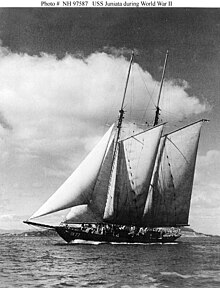 Operation Sail 1976: T/S Te Vega on the Hudson River.
| |
| History | |
|---|---|
| Name | Etak |
| Builder | Friedrich Krupp Germaniawerft Kiel, Germany |
| Launched | 1930 |
| Identification |
|
| Name | Juniata IX-77 |
| Namesake | Juniata River |
| Operator | US Navy |
| Acquired | 1942 |
| In service | 11 August 1942 |
| Out of service | 1 January 1945 |
| Fate | Sold to civilian |
| General characteristics | |
| Type | Gaff-rigged auxiliary schooner |
| Tonnage | 242 |
| Length | 137 ft (42 m) |
| Beam | 28 ft 2 in (8.59 m) |
| Draft | 17 ft 5 in (5.31 m) |
| Propulsion | |
| Speed | 11 kn (20 km/h; 13 mph) |
Te Vega is a two-masted, gaff-rigged auxiliary schooner. Originally launched as the Etak, she was designed by New York naval architects Cox & Stevens in 1929 for American businessman Walter Graeme Ladd and his wife, Catherine ("Kate") Everit Macy Ladd. Etak ("Kate" spelled backwards) was built at the Friedrich Krupp Germaniawerft shipyard in Kiel, Germany, and launched in 1930. During World War II she served the US Navy as Juniata (IX-77). She is among the largest steel-hulled schooners afloat.
The Etak has been renamed several times, her subsequent names being Vega, USS Juniata and Te Vega. She is currently Deva.
The ship has changed hands over fifteen times and has undertaken a variety of functions: private yacht, United States Navy patrol vessel during World War II, charter yacht in the West Indies and French Polynesia, research vessel for Stanford University's Hopkins Marine Station, and school ship for seaborne prep school the Flint School. She is one of the many tall ships to have appeared in a feature film, the cinerama travelogue South Seas Adventure.
Some of the ship's more colorful owners have been Adolph Dick of the Dick sugar and banking family of New York; Hans-Wilhelm Röhl, co-owner of the Rohl-Connolly Co. (builder of the Port of Los Angeles breakwaters) and investigated in 1942 for pro-Nazi sympathies; aviation pioneer Thomas F. Hamilton; Crane Co. heir Cornelius Crane; renowned Honolulu-based skipper Omer Darr; Stimson Lumber Company scion Harold Miller; Dutch financier (and kundalini yoga teacher) Pieter Schoonheim Samara; and Calisto Tanzi, ex-chairman of the Parmalat group. In January 2006 she was sold to Italian fashion magnate Diego Della Valle (Tod's et al.).
She was built with a 200-hp American Winton marine diesel engine, which was replaced by a 400-hp English Mirrlees in the 1950s. From the mid-1990s she has had a 700-hp German MTU. Launched with a black hull, she has had white and dark blue hulls as well. She has flown the flags of the United States, France, Liberia, Panama, The Netherlands, and Italy (current).


Allegations were made that Army officers involved in construction of Pacific air ferry routes and bases prior to the war mismanaged the effort and had improper associations with Röhl, particularly with respect to the proposed charter of his yacht Vega as a survey vessel.[1]
The yacht, then named Vega, was offered by Röhl to the United States Coast Guard and accepted on July 9, 1942.[2] Subsequently, Vega was acquired by the US Navy from H. W. Röhl in 1942, renamed Juniata and designated (IX-77).[3] The vessel was placed in service on August 11.[3]
Juniata was assigned to the Western Sea Frontier and was based at San Francisco, California. She alternated with other ships on patrol for the great circle route to Hawaii, sailing to and from her station some 500 miles west of Eureka, California. Juniata was placed out of service at Treasure Island, San Francisco, California, on 1 January 1945, returned to the Maritime Commission, and sold to Thomas Hamilton in June 1945.[3]
The National Science Foundation converted the ship in 1964 for use as a research vessel to be operated by Stanford University.[4] The ship was sold in 1969, replaced by the Proteus.[4]